PhD Position Available
The LPI is recruiting a PhD student to carry out his/her research in the diffusion MRI field. Questions should be directed to Professor Santiago Aja-Fernandez at sanaja@tel.uva.es.
The position has been granted by the Spain Science Ministry and it is linked to the research grant entitled "Diffusion magnetic resonance imaging for precision medicine: from analysis to prediction. Application to migraine ". The PhD must be carried out in the University of Valladolid. The position is subject to an official application to the Ministry.










